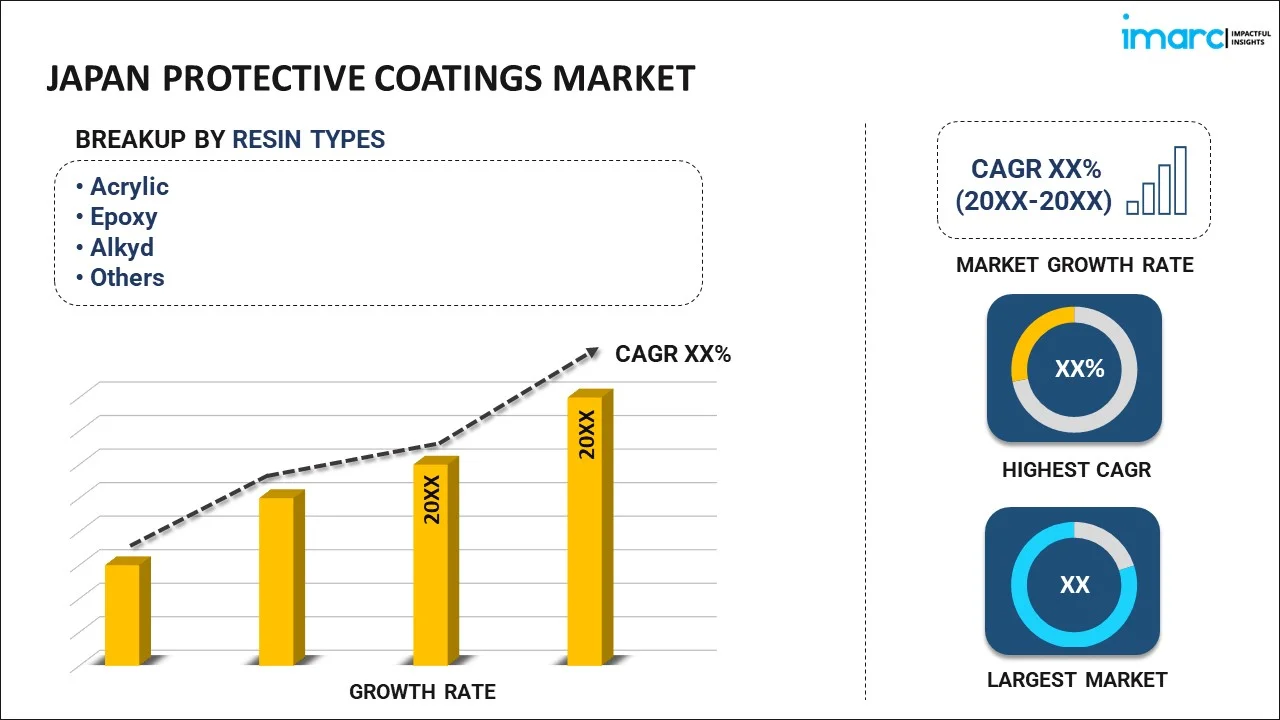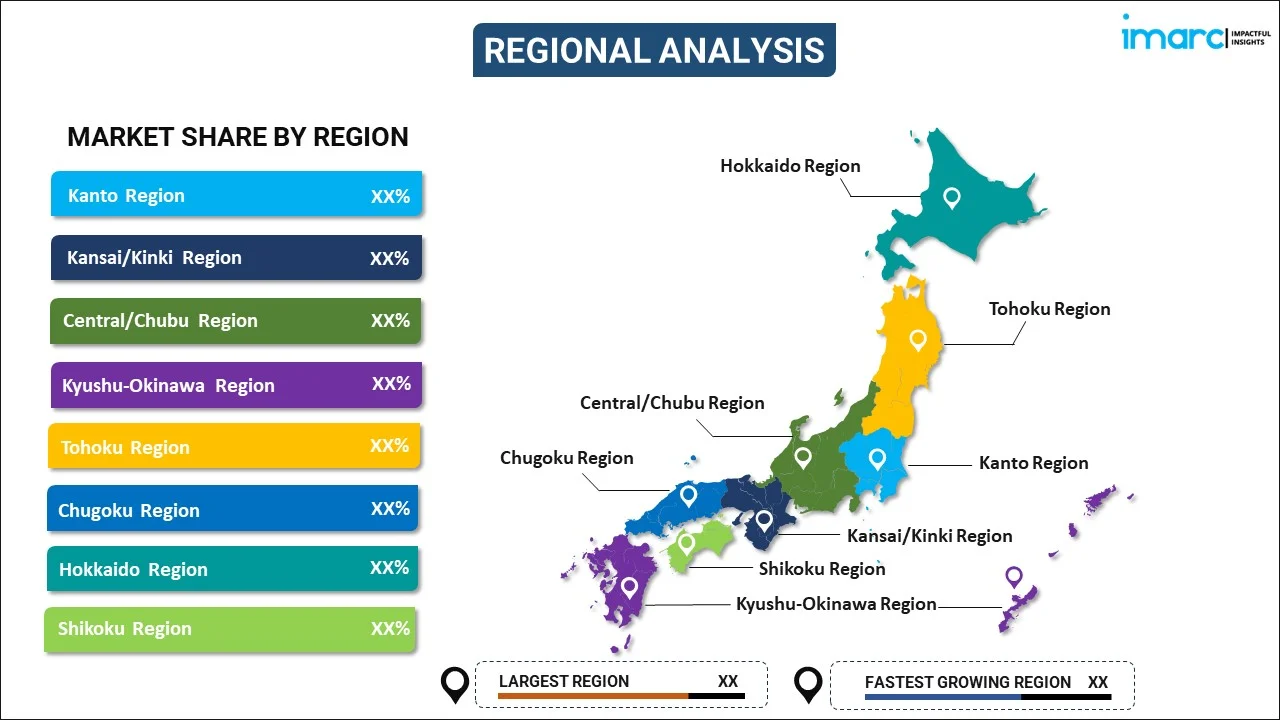
Japan Protective Coatings Market Report by Resin Type (Acrylic, Epoxy, Alkyd, Polyurethane, Polyester, and Others), Technology (Water-borne, Solvent-borne, Powder Coatings, UV-Cured), End Use Industry (Oil and Gas, Mining, Power, Infrastructure, and Others), and Region 2025-2033
Market Overview:
Japan protective coatings market size reached USD 764.5 Million in 2024. Looking forward, IMARC Group expects the market to reach USD 1,242.0 Million by 2033, exhibiting a growth rate (CAGR) of 5.3% during 2025-2033. The expanding automotive industry and the growing need to protect the structural integrity of vehicles against rust and corrosion is primarily driving the protective coatings market.
|
Report Attribute
|
Key Statistics
|
|---|---|
|
Base Year
|
2024 |
|
Forecast Years
|
2025-2033
|
|
Historical Years
|
2019-2024
|
| Market Size in 2024 | USD 764.5 Million |
| Market Forecast in 2033 | USD 1,242.0 Million |
| Market Growth Rate (2025-2033) | 5.3% |
Protective coatings are specialized materials applied to surfaces to safeguard them from various environmental and operational hazards. These coatings serve a vital role in preserving the integrity and longevity of substrates such as metals, concrete, wood, and more. There are several types of protective coatings, each designed to address specific challenges. Common examples include anti-corrosion coatings, which shield metal surfaces from rust and deterioration caused by exposure to moisture and chemicals. Additionally, fire-resistant coatings provide thermal protection by slowing down the spread of flames on surfaces. Protective coatings can also enhance aesthetics, such as paints and varnishes that not only add color but also shield surfaces from weathering and UV damage. Overall, protective coatings play a crucial role in numerous industries, including construction, automotive, aerospace, and marine, helping to extend the lifespan of infrastructure and equipment while maintaining their appearance and functionality. These coatings contribute to safety, durability, and cost-efficiency in various applications.
Japan Protective Coatings Market Trends:
The protective coatings market in Japan has been experiencing robust growth in recent years, primarily driven by several key factors. To begin with, the increasing awareness of environmental concerns has led to a surge in demand for eco-friendly and sustainable coating solutions. Consequently, manufacturers have been investing heavily in the development of environmentally friendly coatings that offer superior protection. Additionally, the rising need for corrosion and abrasion-resistant coatings in several industries, such as automotive, aerospace, and construction, has also propelled market growth. Furthermore, stringent government regulations and safety standards have acted as a strong driver for the protective coatings market. As authorities continue to tighten regulations regarding emissions, fire safety, and health, industries are seeking advanced coatings that can meet these compliance requirements. Moreover, the growing construction and infrastructure development activities in Japan are expected to drive the protective coatings market forward, as they play a pivotal role in extending the lifespan of structures and reducing maintenance costs.
Japan Protective Coatings Market Segmentation:
IMARC Group provides an analysis of the key trends in each segment of the market, along with forecasts at the country level for 2025-2033. Our report has categorized the market based on resin type, technology, and end use industry.
Resin Type Insights:

- Acrylic
- Epoxy
- Alkyd
- Polyurethane
- Polyester
- Others
The report has provided a detailed breakup and analysis of the market based on the resin type. This includes acrylic, epoxy, alkyd, polyurethane, polyester, and others.
Technology Insights:
- Water-borne
- Solvent-borne
- Powder Coatings
- UV-Cured
A detailed breakup and analysis of the market based on the technology have also been provided in the report. This includes water-borne, solvent-borne, powder coatings, and UV-cured.
End Use Industry Insights:
- Oil and Gas
- Mining
- Power
- Infrastructure
- Others
The report has provided a detailed breakup and analysis of the market based on the end use industry. This includes oil and gas, mining, power, infrastructure, and others.
Regional Insights:

- Kanto Region
- Kansai/Kinki Region
- Central/ Chubu Region
- Kyushu-Okinawa Region
- Tohoku Region
- Chugoku Region
- Hokkaido Region
- Shikoku Region
The report has also provided a comprehensive analysis of all the major regional markets, which include Kanto Region, Kansai/Kinki Region, Central/ Chubu Region, Kyushu-Okinawa Region, Tohoku Region, Chugoku Region, Hokkaido Region, and Shikoku Region.
Competitive Landscape:
The market research report has also provided a comprehensive analysis of the competitive landscape in the market. Competitive analysis such as market structure, key player positioning, top winning strategies, competitive dashboard, and company evaluation quadrant has been covered in the report. Also, detailed profiles of all major companies have been provided.
Japan Protective Coatings Market Report Coverage:
| Report Features | Details |
|---|---|
| Base Year of the Analysis | 2024 |
| Historical Period | 2019-2024 |
| Forecast Period | 2025-2033 |
| Units | Million USD |
| Scope of the Report | Exploration of Historical Trends and Market Outlook, Industry Catalysts and Challenges, Segment-Wise Historical and Future Market Assessment:
|
| Resin Types Covered | Acrylic, Epoxy, Alkyd, Polyurethane, Polyester, Others |
| Technologies Covered | Water-borne, Solvent-borne, Powder Coatings, UV-Cured |
| End Use Industries Covered | Oil and Gas, Mining, Power, Infrastructure, Others |
| Regions Covered | Kanto Region, Kansai/Kinki Region, Central/ Chubu Region, Kyushu-Okinawa Region, Tohoku Region, Chugoku Region, Hokkaido Region, Shikoku Region |
| Customization Scope | 10% Free Customization |
| Post-Sale Analyst Support | 10-12 Weeks |
| Delivery Format | PDF and Excel through Email (We can also provide the editable version of the report in PPT/Word format on special request) |
Key Questions Answered in This Report:
- How has the Japan protective coatings market performed so far and how will it perform in the coming years?
- What has been the impact of COVID-19 on the Japan protective coatings market?
- What is the breakup of the Japan protective coatings market on the basis of resin type?
- What is the breakup of the Japan protective coatings market on the basis of technology?
- What is the breakup of the Japan protective coatings market on the basis of end use industry?
- What are the various stages in the value chain of the Japan protective coatings market?
- What are the key driving factors and challenges in the Japan protective coatings?
- What is the structure of the Japan protective coatings market and who are the key players?
- What is the degree of competition in the Japan protective coatings market?
Key Benefits for Stakeholders:
- IMARC’s industry report offers a comprehensive quantitative analysis of various market segments, historical and current market trends, market forecasts, and dynamics of the Japan protective coatings market from 2019-2033.
- The research report provides the latest information on the market drivers, challenges, and opportunities in the Japan protective coatings market.
- Porter's five forces analysis assist stakeholders in assessing the impact of new entrants, competitive rivalry, supplier power, buyer power, and the threat of substitution. It helps stakeholders to analyze the level of competition within the Japan protective coatings industry and its attractiveness.
- Competitive landscape allows stakeholders to understand their competitive environment and provides an insight into the current positions of key players in the market.
Need more help?
- Speak to our experienced analysts for insights on the current market scenarios.
- Include additional segments and countries to customize the report as per your requirement.
- Gain an unparalleled competitive advantage in your domain by understanding how to utilize the report and positively impacting your operations and revenue.
- For further assistance, please connect with our analysts.
 Inquire Before Buying
Inquire Before Buying
 Speak to an Analyst
Speak to an Analyst
 Request Brochure
Request Brochure
 Request Customization
Request Customization




.webp)




.webp)












